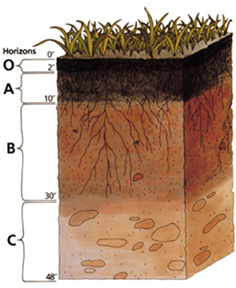This lesson will build participants’ understanding of the importance of soil food webs by directly measuring carbon dioxide production due to soil organism respiration in samples from a variety of habitat types. Differences between annual and perennial crop field soils, as well as those from forests and lawns, will be used to highlight the important differences in carbon storage rates among these soil types. The main activity will be a titration lab determining the CO2 production from soil microcosms caused by microbial respiration. A class demonstration using Vernier probes will measure the same variable as a comparative method. A brief introduction to global carbon cycling and soil ecosystem components will precede the lab work.
Upon completion of this lesson, students will be able to:
- Measure CO2 production from soil respiration with at least two methods.
- Identify some of the major groups of organisms active in soil food webs, and their connection to global carbon cycling.
- Explain how different plant communities affect the amount and type of organic carbon stored in their soils.
- Predict how changes in human management practices of various communities are likely to affect soil carbon respiration rates in their soils.
Resources:
- Lesson plan (.doc)
- Lab protocol handout (.doc)
- “Description of Soil Microbe Community” Handout (.docx)
- Carbon Cycle Diagram (.docx)
- Assessment questions (.docx)
Lesson Plan created by GK-12 Fellow Jonathon Schramm, 2009

